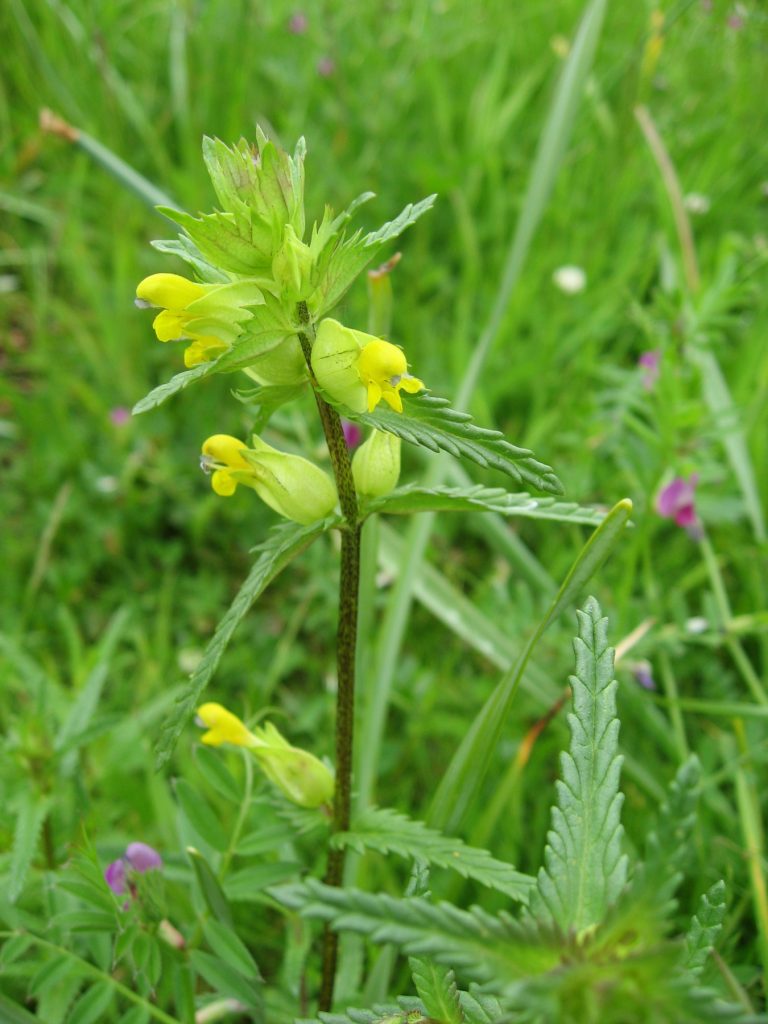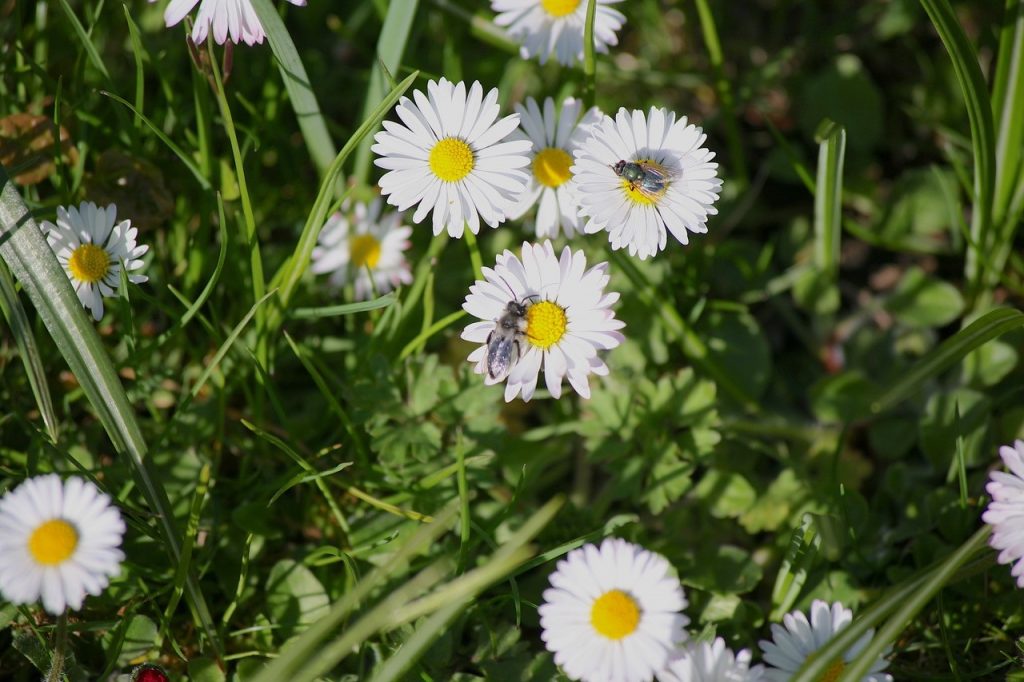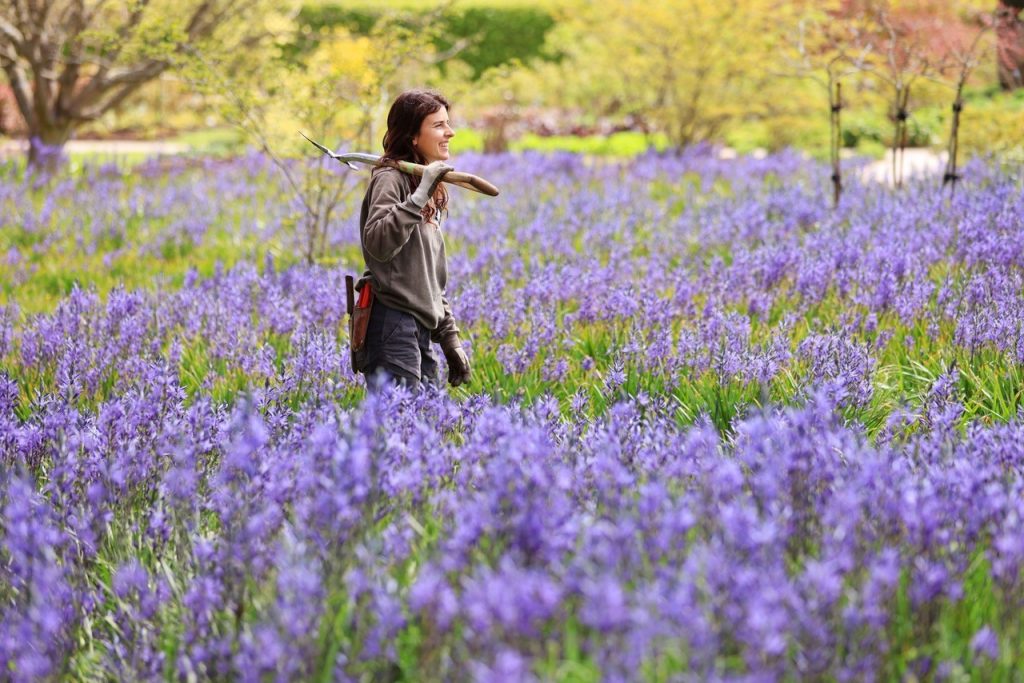
I’m probably going to cause a riot, although I’m not a Kaiser Chief! I believe the bowling green lawn, the one with the counter-running corduroy-like stripes, is fine for Premier League footballers but not for gardeners. It’s old hat and trying to maintain that level of perfection means killing the daisies and the moss with a chemical cocktail. Garden centres are full of lawn-related products and a lot of needless chemical intervention takes place in order to create the perfect lawn. Chemicals are very harmful to wildlife – and that includes us by the way.
In any case my daisies proved vital this year, because they flowered in April when everything else was still laying low due this year’s low cold spring temperatures. My ashy mining bees (Andrina cineraria) would not have survived without daisy nectar and pollen, or the long grass.
The perfect lawn needs aerating, feeding and it watering and it goes without saying that water is a precious resource these days, due to climate change. It should not be wasted on boring old lawns that have been mown to within an inch of their life. They’re destined to brown very quickly when heat strikes, but they also revive within days. Keep your water for your greenhouse instead and let your lawn develop into a flowery mead. It’s pleasing on the eye and the extra flowers in the lawn will provide more pollen and nectar for pollinators.
You’ll also get brown butterflies skipping through your garden too, because the commoner members of this family lay eggs on grasses. There’s nothing more relaxing than watching newly-hatched, dusky ringlet butterfly lolling about the garden in early July, in that lazy way they have. Quite different from the fast-flying skippers who like to sunbathe on foliage, once they’ve zoomed about. Small mammals, birds and amphibians will also appreciate your grassy sward.
My own Spring Cottage ‘flowery mead’ surrounds a Blenheim Orange apple tree and an apricot, although the latter only fruits following a frost-free spring. It was inspired by two events in my life. One was a spring-time visit to a garden in Worcestershire, owned by the late Terry Dagley, some twenty-five years ago. Terry had bulb lawns with interesting miniature bulbs and these were sectioned off with sticks arranged in a cross-stitch pattern. The grass around them was mown and this provided a sharp contrast that stopped it looking messy. It was colourful and neat, so I began to use the same system straight away and I planted jaunty ‘Jetfire’ daffodils and blue muscari, scillas and chionodoxas.
The second main event was an interview with Matthew Oates, about fifteen years ago. At the time Matthew, who’s the leading authority on purple emperor butterflies, was the National Trust’s butterfly expert. The Trust had changed their maintenance regime, because mowing was time-consuming and expensive when it came to manpower and fossil fuel. They decided to cut simple paths through the grass and let the rest grow.

Two things happened in short order. Wild flowers and meadow grasses returned, because their seeds were still in the soil. In the following year the gardeners noticed a rise in brown butterfly numbers, including skippers, ringlets, meadow browns and gatekeepers. Garden visitors enjoyed seeing the grass rippling in the breeze and the flora and fauna were an added bonus. This encouraged me to follow the Trust’s lead and let my lawn grow. Two meadow grasses soon popped up, Crested dog’s tail grass (Cynosurus cristatus) and sweet vernal grass (Anthoxanthum odoratum). Meadow cranesbill ( Geranium pratense) and common vetch (Viccia sativa) also returned.
The next step was to plant some seeds of a hemi-parasitic annual called yellow rattle (Rhinanthus minor). This feeds on grassy roots and thins the grass and creates gaps. I sowed this thickly in early September, after the last mow. I began with a small area and now it flowers throughout my mini meadow. I’ve tried to introduce commercially grown dactylorhiza orchids, but it’s probably too cold and dry here. I’ve raised wildflower plugs of bird’s foot trefoil (Lotus corniculatus) and had dingy skippers in the garden, because it’s one of their food plants.
In summer visitors to the garden are drawn to the patch, although the floral procession begins with our pallid-yellow, native daffodil, a form of Narcissus pseudonarcissus. This spreads by self-seeding. so it must not be deadheaded. My Cowslips set seed too and they hybridise with my many named primroses to produce a medley of browns and golds. The hairy-footed flower bee females, completely black fast-flying bees named Anthophora plumipes, home in on the cowslip flowers and they also adore comfrey. Their tongues are long enough to get to the nectar and their hairy legs get dusted with pollen in the process, just like me when I ice a cake. The pollen gets stuck on this bee’s hairy legs and forms long, blocky bright-yellow rectangles. If it’s black, fast-flying and it’s about in April and early May it’s almost certainly a hairy-footed flower bee.
The rather variable cowslips-cum-primroses chime with self-seeding fritillarias and I do far better with F. pyrenaica here than the moisture-loving snake’s-head fritillary or F. meleagris. If you’re garden’s low-lying (which mine isn’t) you may find the reverse for this is a flower of low-lying river meadows. Tulip ‘Queen of Night’ appears to be increasing by seed and coming true to type, so in April the colour theme is a mixture of yellows and burnished browns.

May is made glorious by the arrival of blue, starry-flowered camassias and I buy blue forms of C. leichtlinii from Peter Nyssen, at roughly a pound a piece, because I let these self-seed too. Camassias are easily grown in grass and they make large clumps, with up to nine flowering stems or more. They self-seed to form natural colonies. HRH Prince Charles relies on them in the meadow at Highgrove House in Gloucestershire, but they also grow at RHS Wisley ( pictured). Like all spires of flowers, they perform for many weeks – but it’s the blue-flowered forms that are strongest.
C.leichtlinii is the one to grow and it’s known as the great camas because it can reach a metre in height. It flowers two weeks later than the shorter C. quamash and flowering spike lasts a long time, because only three or four open at one time. The grey-blue starry flowers are completely symmetrical and there are white forms and double forms. This species, named after Maximilian Leichtlin (1831- 1910, the founder of Baden Baden’s botanic garden, grows in damp mountain meadows in the western USA so it prefers an open situation in soil that doesn’t dry out.
The area around the flowery mead, as we call it, is neatly mowed. The whole area gets on cut in late-September and the clippings are left for a day ot two, to allow seeds to dehisce or drop, and then the clippings are gathered up and placed on the compost heap. The picking up quickly is vital. If it’s allowed to rot down, it will produce a nitrogen boost and encourage the coarse grasses at the expense of the wild flowers.
One day I might go the whole hog and only mow one strip right round it. I may not live at Highgrove House, but I’m creating my own mini paradise meadow here. It’s pulling in the wildlife and lifting my spirits – sop you really should try it!



